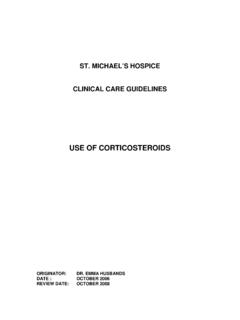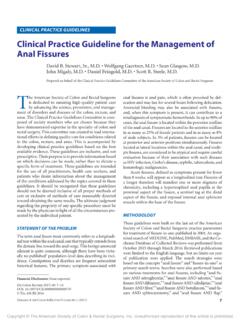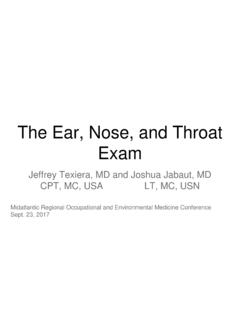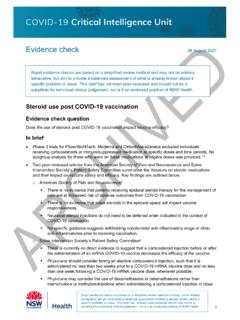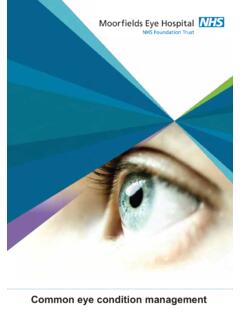Transcription of Chronic Wound Care Guidelines
1 ChronicWound Care GuidelinesAbridged VersionThe Wound Healing SocietyTable of Ulcer ..4 Pressure Ulcer ..10 Diabetic Ulcer ..16 Arterial Insufficiency Ulcer ..22 References ..28 The Wound Healing Society2 The publication of the Wound Care Guidelines by the WoundHealing Society in the December 2006 issue of Wound Repair and Regenerationrepresents the culmination of a three-year effortinvolving numerous individuals and entities. As the PrincipalInvestigator and Chief Editor of this work, I think that a briefhistory of the genesis and completion of this project is absolutelynecessary. In addition, it allows for the recognition of the effort by so many into the development of this project. In early 2003, the Wound Healing Foundation, under theleadership of Dr. Elof Eriksson, put out a request for proposal(RFP) for a project to formulate and publish Minimal Standardsfor the Diagnosis and Treatment of Chronic Wounds: General andSpecific.
2 The RFP emphasized that the most common chronicwounds pressure ulcers, venous stasis ulcers and diabetic footulcers are increasing in prevalence in the population, owingprimarily to an ever-increasing number of elderly , despite many recent advances in Wound care, thechallenge of managing Chronic wounds is compounded by thecurrent lack of uniformly accepted diagnostic methods to evaluateoutcomes and consensus on clearly defined, comprehensive woundcare standards. The WHS was extremely gratified when its proposal wasaccepted. The committees and respective Chairs were selected andcharged with the necessary research and writing in June 2005. Thesuccessful completion of their task within a short period of six toeight months bespeaks of their hard work, dedication to the goalsof the project and unwavering commitment.
3 Several unique features of this project need to be , consensus was the order of the day and was maintainedthroughout: in the broad and comprehensive research of existingliterature; in the make-up of work groups to include all specialties,disciplines, professional degrees or societies (various clinicalfields such as dermatology, endocrinology, vascular surgery,plastic surgery, podiatric medicine, geriatrics, nursing,dietetics/nutrition, rehabilitative services and prosthetics are allFOREWORD3represented); in the application of Delphi process in that the vastmajority of the group had to be in agreement with any pronouncementor recommendation; and, finally, in the seeking of input from allinterested parties, societies and industry at publicly held forumson the NIH campus in October 2005 and February 2006. The astute reader will notice that the term standard wasdropped in favor of the term guideline.
4 It was felt that the latterterm more accurately reflected the intent, the frequent lack ofstrong evidence or the legal implication of the former to these documents are: the inclusion of animal data asreflective of biological, if not necessarily clinical, evidence; thelack of any agenda, as no industrial or other interest group orfunding was sought; and, finally, the inclusion of clinicians,academicians and bench scientists in the publication of the Guidelines represents only a WHS has formed a Guideline Update Committee chaired byDr. Martin Robson. Its duties include the continued examinationof the validity and currency of the documents, as well as theirperiodic update and would like to conclude by recognizing several individualswho have helped and encouraged me in this project: Dr. ElofEriksson, whose unwavering trust, help and friendship have beeninvaluable and who remains as committed today as he was in 2003to the value of this project; his efforts in diplomacy and scienceare a constant source of inspiration; Dr.
5 Lillian Nanney, whosefaith and trust in me was an impetus to complete the project; tothe Chairs of the four committees: Drs. Martin Robson, DavidSteed, Harriet Hopf, Joie Whitney and Linda Phillips, all of whomkept their focus, the time frame imposed and required virtually no urgings on my part; all committee members whose work is trulyrepresented Barbul, MD, FACSP resident, The Wound Healing Society41. disease should be ruled out: Pedal pulses are present ABI > ABI < suggests vascular disease; if ABI < then compression therapy is contraindicated. In elderly patients, diabetic patients or patients with ABI > , Toe:brachial index > or transcutaneousoxygen pressure of > 30 mm Hg may help to suggestadequate arterial duplex ultrasound scanning or Valsalva maneuver isuseful in confirming venous suspecting sickle cell disease, diagnose with sickle cell prepand hemoglobin ulcer is older than three months or not responsive after sixweeks of therapy, biopsy for histological diagnosis (possiblemalignancy or other disease).
6 Worsening despite treatment or excessively painful, considerother diagnoses such as pyoderma gangrenosum, IgAmonoclonal gammopathies, Wegener's granulomatosis,cutaneous Chronic granulomatous disease and mycobacterialor fungal etiologies (high suspicion for ulcers with dark color,blue/purple border, concomitant with systemic disease such asCrohn's disease, ulcerative colitis, rheumatoid arthritis, othercollagen vascular diseases, leukemia). Specific cultures formycobacteria and/or fungi are useful, as biopsies for Lower Extremity Compression of Class 3, high-compression system is indicated. The degree of compression must be modified when mixedvenous/arterial disease is confirmed during the pneumatic leg compression (IPC) can be usedwith or without compression (other option for patients whocannot or will not use adequate compression).
7 Becausevenous hypertension is an ongoing condition, a degree ofcompression therapy should be continued constantly andforever. (See Long-Term Maintenance Guidelines on Page 9.)VENOUS ULCER53. Infection necrotic, devitalized tissue by sharp, enzymatic,mechanical, biological or autolytic Assessment infection is suspected in a debrided ulcer, or ifepithelialization from the margin is not progressing withintwo weeks of debridement and initiation of compressiontherapy, determine the type and level of infection in thedebrided ulcer by tissue biopsy or by a validated quantitativeswab 106 CFU/g of tissue or any beta hemolytic streptococci,use topical antimicrobial (discontinue once in bacterialbalance to minimize cytotoxicity and development ofresistance). Systemically administered antibiotics do noteffectively decrease bacterial levels in granulating wounds;however, topically applied antimicrobials can be (inflammation and infection of the skin andsubcutaneous tissue most commonly due to streptococci orstaphylococci) around ulcer should be treated with systemicgram-positive bactericidal the tissue level of bacteria, preferably to 105 CFU/g of tissue, with no beta hemolytic streptococci in thevenous ulcer prior to attempting surgical closure by skin graft,skin equivalent, pedicled or free ULCER 64.
8 Wound Bed Preparation patient as a whole to evaluate and correct causes oftissue damage:A) Systemic diseases (autoimmune diseases, major surgery, Chronic smoking) and medications (immunosuppressivedrugs and systemic steroids)B) NutritionC) Tissue perfusion and oxygenation Debridement initial debridement and maintenance debridement(sharp, enzymatic, mechanical, biological or autolytic). Choose method of debridement depending on the status of thewound, the capability of the healthcare provider and theoverall condition of the patient. Cleansing Wound initially and at each dressing change using aneutral, nonirritating and nontoxic solution. Routine woundcleansing should be accomplished with a minimum ofchemical and/or mechanical trauma. Sterile saline or water is usually recommended. Tap watershould only be used if the water source is reliably nontoxic surfactant may be useful, as may fluid deliveredby increased intermittent pressure.
9 Documentation of Wound Wound history, recurrence and characteristics(location, staging, size, base, exudates, infection condition ofsurrounding skin and pain). The rate of Wound healing shouldbe evaluated to determine if treatment is ULCER75. dressing that maintains a moist Wound healing clinical judgment to select moist Wound dressing thatfacilitates continued moisture. Wet-to-dry dressings are notconsidered continuously moist and are an inappropriatewound dressing dressing to manage exudates and protect peri- Wound a dressing that stays in place, minimizes shear andfriction, and does not cause additional tissue ULCER PATIENTS ARE PARTICULARLYSUSCEPTIBLE TO CONTACT DERMATITIS RELATEDTO TOPICAL dressing that is cost-effective and appropriate to theulcer etiology, the setting and the provider.
10 Consider healthcareprovider time, ease of use and healing rate, as well as the unitcost of the grafting without attention to the underlying venousdisease is not a long-term solution and is prone to endoscopic perforator surgery (SEPS) is theprocedure of choice to address underlying venous pathologicetiology (with or without skin grafting or use of a bilayeredartificial skin). extensive surgery on the venous system, such assuperficial venous ablation, endovenous laser ablation orvalvuloplasty, especially when combined with compressiontherapy, can be useful in decreasing the recurrence of venousleg ulcers. Procedures that are less extensive than deepligation of multiple perforating veins can help to decreasevenous hypertension when combined with an adequatecompression flap transfer with microvascular anastomoses can benefitrecalcitrant venous leg ulcers with severe lipodermatosclerosisby allowing wide excision of diseased tissue and providinguninjured venous valves in the transferred ULCER87.

